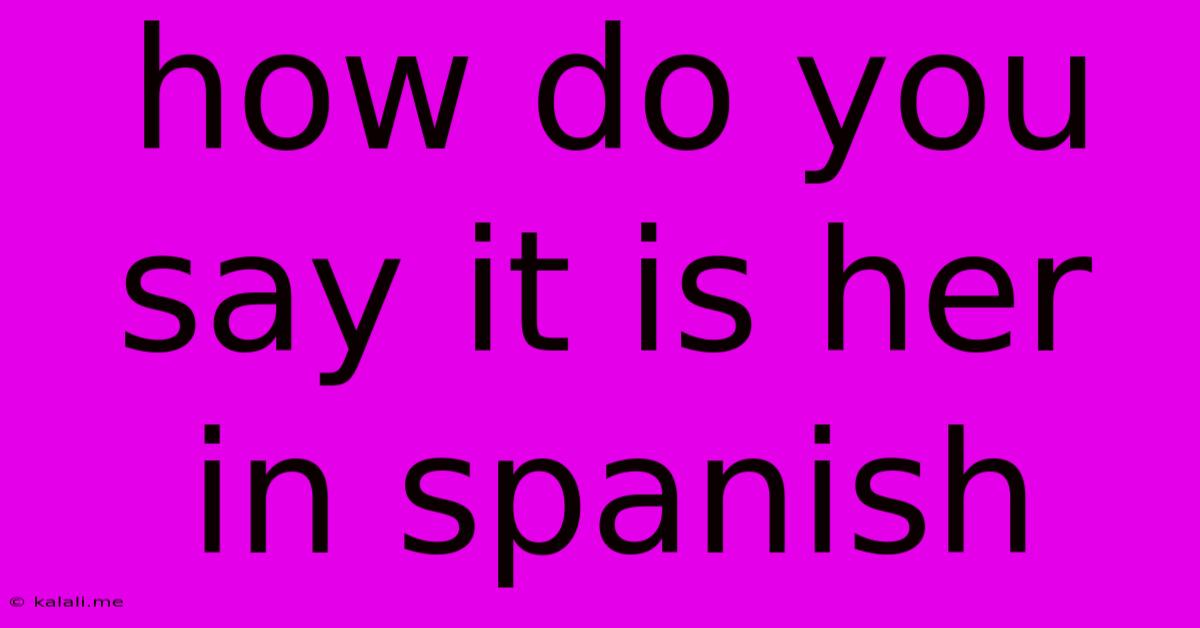How Do You Say It Is Her In Spanish
Kalali
Jun 07, 2025 · 2 min read

Table of Contents
How Do You Say "It Is Her" in Spanish? A Comprehensive Guide
This article will delve into the various ways to express "it is her" in Spanish, exploring the nuances of grammar and context that influence the best translation. Understanding these nuances will help you speak and write Spanish more accurately and naturally.
The most common translation of "It is her" in Spanish is "Es ella." This is a straightforward and widely accepted translation that works in most situations. "Es" is the third-person singular form of the verb "ser" (to be), and "ella" means "she" or "her."
However, the best way to translate "it is her" depends heavily on the context. Let's explore some scenarios and their corresponding translations:
Different Contexts and Their Translations
-
When identifying someone: If you're pointing to a woman and saying "It's her," "Es ella" is perfect. For example, "¿Es ella la doctora?" (Is she the doctor?)
-
After a preposition: When "her" follows a preposition, the translation changes slightly. Instead of "ella," you'll use the pronoun "la."
- "It's for her": "Es para ella."
- "It's with her": "Está con ella." (Note the use of "estar" here which signifies location or state of being)
- "It's about her": "Es sobre ella." or "Trata de ella." (The latter means "It's about her")
-
Emphasis: To emphasize "her," you can use phrases like:
- "It's definitely her.": "Es ella sin duda." or "Definitivamente es ella."
- "It was actually her.": "Fue ella en realidad." (Note the use of "fue," the past tense of "ser")
-
Indirect Objects: If "her" is an indirect object (receiving the action indirectly), you might use "le" instead. This is typically used with verbs that take indirect objects like "dar" (to give) or "decir" (to tell). However, because "le" can also mean "him," clarity is often needed.
- "I gave it to her.": "Se lo di." (This uses a pronoun combination for clarity)
- "I told her the truth.": "Le dije la verdad." (Here, the context makes the meaning clear.)
Understanding the Verbs "Ser" and "Estar"
The choice between "ser" and "estar" is crucial in Spanish. While both translate to "to be," they have distinct meanings:
- Ser: Indicates inherent qualities, identity, origin, or time. Think of it as "to be" in the sense of essential being.
- Estar: Indicates temporary states, location, or conditions. Think of it as "to be" in the sense of a temporary state or location.
Therefore, in most cases when translating "It is her," "ser" is the correct verb to use because you're stating her identity.
Practice Makes Perfect!
The best way to master these nuances is through practice. Try using these different phrases in sentences and conversations to solidify your understanding. The more you expose yourself to Spanish, the more naturally you will choose the most appropriate translation for "it is her" in various contexts. Remember to pay attention to the context of the sentence and the relationship between the subject and the object.
Latest Posts
Latest Posts
-
Do You Need An Id For A Bus Ticket
Jun 07, 2025
-
How Much Caffeine In Cold Brew Coffee
Jun 07, 2025
-
Best Cheapest Non Box Store Mountain Bike
Jun 07, 2025
-
Is Dissolving Sugar In Water A Chemical Change
Jun 07, 2025
-
How To Say You Re Welcome In French Language
Jun 07, 2025
Related Post
Thank you for visiting our website which covers about How Do You Say It Is Her In Spanish . We hope the information provided has been useful to you. Feel free to contact us if you have any questions or need further assistance. See you next time and don't miss to bookmark.